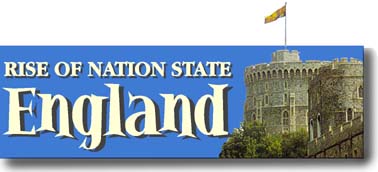|
Highlands Ranch High School - Mr. Sedivy
Highlands Ranch, Colorado
Rise of Nation State England
- Magna Carta / First Parliament
-
King Henry III, Simon de Monfort
Magna Carta
Magna Carta (Latin, meaning Great Charter). An impression of the
Great Seal was attached to it. Many copies of the Great Charter
were made by royal clerks in the summer of 1215. Magna Carta was
granted to all freemen of England, but the barons gained most from
it.

Version of Magna Carta 1225, the third reissue with
amendments.
Click the document for an
enlargement.
John was not to ask for scutage until his tenants-in-chief had
agreed to it. Relief was fixed at £100. John had considered
the giving of justice to be a personal favor which he could refuse
if he wanted to. He made some unfortunate barons pay large sums
of money just to get a fair trail. John was not to sell or deny
justice to anyone.
A committee of twenty-five barons was chosen to keep a check on
the King. He preferred to fight rather than allow barons to sit
in judgment on him. So in September 1215, civil war broke out again.
John hired soldiers from the Continent and put up a strong resistance.
On the night of October 18, 1216, he died suddenly at Newark in
Nottinghamshire, after heavy eating and drinking.
"At his end," wrote a chronicler, "few mourned for him." However,
John's death did not mean Magna Carta was forgotten. It became part
of the law of the land and in the years ahead barons made sure that
the kings remembered what it said.
Henry III (1216 - 1272)
John's nine-year old son was crowned King Henry III. A group of
loyal barons began to govern the country until the boy was old enough
to rule.
 
Left: Illuminated manuscript shows Henry III holding
one of his churches.
Right: Gilt-bronze-effigy of King Henry III in Westmenster Abbey.

Henry commissioned ecclesiastical buildings, most
notably Westminster Abbey. Henry is shown directing construction
at Westminster Abbey, built to house the shrine of Edward the Confessor.
He allowed his French wife, Eleanor, to crowd his court with her
friends and relations. Foreigners were given large estates and important
lands. Henry even allowed the Pope to appoint about 300 foreign
clergymen to English churches. Henry was forced to hand over most
of his power to a council of fifteen barons led by Simon Monfort.
Simon de Monfort / First Parliament
For a while, Monfort was practically the ruler of England. He held
a Great Council to which he invited not only the nobles who supported
him but also the representatives of ordinary freemen. Each county
was asked to send two knights, and each town that was friendly to
him sent two burgesses (citizens). This sort of assembly later came
to be called a "Parliament."
The rule of Simon de Montfort came to a sudden end in the summer
of 1265. Many of his followers changed sides ,and he was defeated
by Prince Edward, the King's eldest son. Edward took Simon de Montfort's
idea. From time to time, he invited knights and burgesses to attend
his Great Council of nobles. He listened to their complaints and
asked them to agree, in the name of the people to the collection
of certain taxes.
These gatherings gave the king and his subjects a chance to parley
(talk). This is how we get the word "Parliament."

King Edward I presiding over a Parliamentary session,
c.1278. Below the dais, the justices and law officers sit in the
center on woolsacks. Two clerks note the proceedings. The lords
are mostly on the kng's left, and the bishops and abbots are on
his right. (No commons are present on this occasion.)
Lords and Commons
The Barons and Bishops of the Great Council were known as the "Lords"
- The knights and burgesses, and the "Commoners." This is how the
two houses of parliament were developed: Lords and Commons.
"Le roi le veult." The king
wills it - it becomes law.
Back to top of page
Mr. Sedivy's Lecture Notes
& Historical Info
The Celts
| Gallic He-Men | Celtic
Culture, Trade, Religion, Women |
| Threat of the Celts - Celtic Battles and
Conquests |
- Rise of Nation State England -
| Roman Conquest of Britain | Christianity
in Britain |
| Customs: Thanes, Churls, Thralls, Wergeld,
Folk-Moot |
| Dark Ages: Alfred the Great, Edward the
Elder, Athelstan |
| The Return of the Vikings |
| Kings of Britain: Aethelred, Cnut, Edward
the Confessor |
| Bayeaux Tapestry, William the Conqueror,
Edward the Confessor, Harold Godwinson, Harold II |
| The Crusades: Richard Lion Heart, Pope
Urban |
| King John, Innocent III, Archbishop Stephen
Langton |
| Magna Carta / First Parliament |
Wales and Scotland
| Wales: Edward I, Llewellyn, Snowdonia
|
| Scotland: Alexander III, John Balliol,
William Wallace, Robert Bruce, King Edward II |
The 100 Years War
| Edward III, Longbows at Crecy, Edward IV,
Black Prince |
| Henry V, King Charles VI, Battle at Calais,
Treaty of Troyes |
More Information
| Other Kings of the Dark and Middle Ages:
William II, Henry I, Henry II |
| The
British Monarchy's Peerage: Dukes, Viscounts,
Marquess, Earls, Baronets, and Barons |
Class Activities
Roman Conquest Comparison
Battle of Agincourt
Related Information
Mr. Sedivy's World History - The Middle
Ages
The Complete Bayeux Tapestry
Roman Catholic Church in the Middle Ages
/ Crusades
The Hundred Years War
King Henry VIII
The Interesting
Life of Elizabeth I
The Stuarts - James I, Charles I, Charles
II, James II
Oliver Cromwell
|



![]() 9375 South Cresthill Lane
9375 South Cresthill Lane ![]() Highlands Ranch, Colorado 80126
Highlands Ranch, Colorado 80126 ![]() 303-471-7000
303-471-7000





